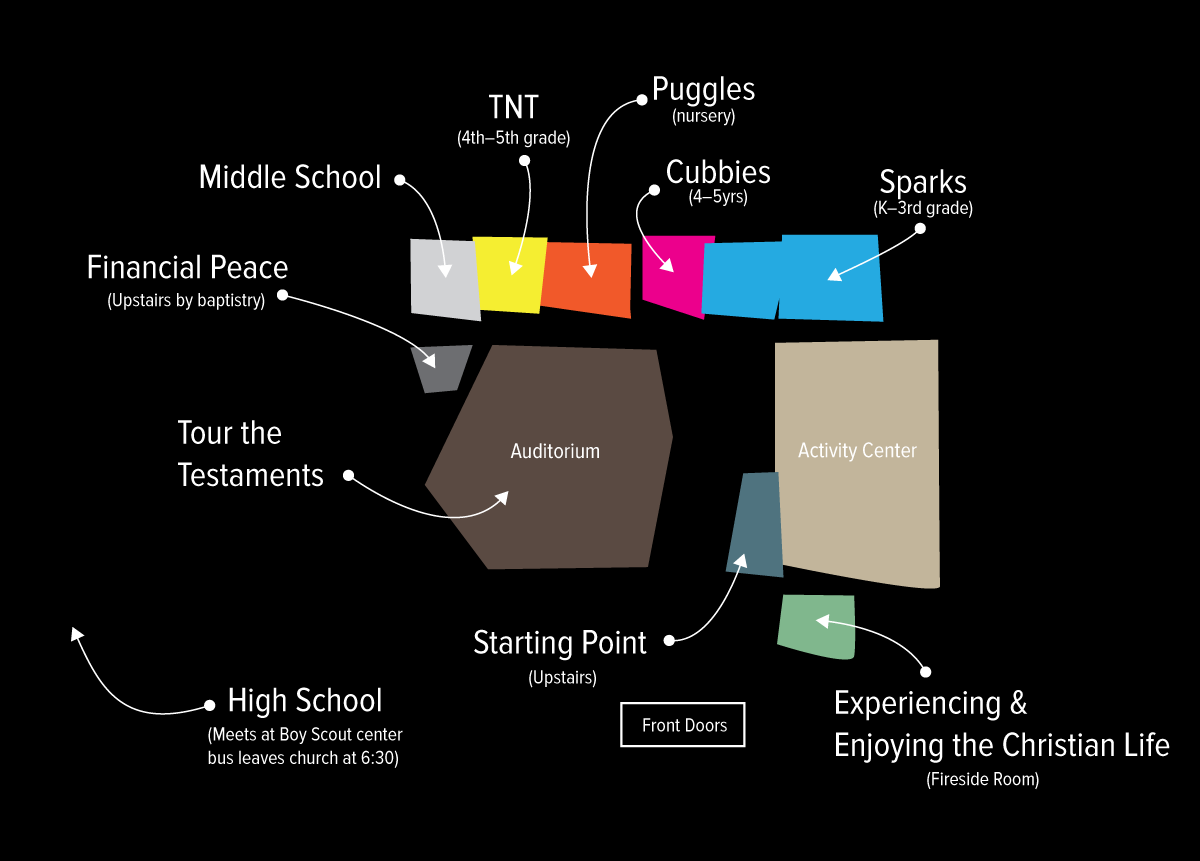Church Signage – The Map
This is the first post in a series that will discuss ideas, give tips and show what we are doing to help people navigate around our church.
One of the most important things for a guest or anyone in your church to help them navigate is a good map which shows where things are.
We've created three specific maps for our two services on Sunday and Wednesday night activities.
Our Wednesday night activities map is below.

I had three goals for our maps.
Keep it Simple
Nobody needs to know exactly where the janitor closet is and no one cares where the Awana ball room is. We only needed key areas for orientation like the front doors, auditorium, and activity center.
I then added each relevant classroom. Not every room is on the map because not every room needs to be there. These are the major areas.
Keep it Clear
On the map itself there are no descriptions of what each class or room is. If needed you can put those in a key below. I also color coded each room for greater clarity. I could have just used the boxes with arrows but adding in color differentiated the rooms and gives a lot of visual contrast to point people in the right direction.
Make it Not Boring
Originally I had a blueprint layout of the building which wasn't very fun. Also not fun is listing each class next to a number. I found the visual key was to use the actual layout of the building and then throw in a fun graphical twist.
We use these in poster frames at key areas in the building, as handouts for new guests and on standing kiosks when a guest first enters the doors.


Three Ways To Avoid Being An Awkward Church Greeter
You've all been there.
A person you don't recognize is walking towards you and your mind is racing furiously trying to place their face. Do you know them? Have they been here before? All of these thoughts are registering on your face as your brow furrows and you frown trying to search the recesses of your memory.
Its the moment of no return. Do you make eye contact and risk saying hi and the awkward conversation to follow, or do the safe thing and look away?
As someone who cares about new people being comfortable in our church I want to know who these new people are. Unfortunately, like the majority of people I have to work at it...hard.
In a larger church one of the biggest obstacles to meeting new people is not being confident that they are actually new. I'm sure all of you reading this have greeted someone you thought was new only to find out they've been attending for the past 4 years and is a deacon.
That embarrassment factor alone keeps us from really greeting people as we should and in the process many new people slip through the cracks unnoticed or they feel a cold shoulder.
Its not that people in churches are unfriendly, in fact they want to be so friendly and polite they don't want to risk offending a guest by asking if they are new in case they're not.
So what can your greeting team and regular attenders of your church do to combat this?
1. Get over yourself.
Yes, its embarrassing to meet a new person that has been attending for 6 months but more than likely they didn't recognize you either. But really if you care for people and don't want them to fall through the cracks you've got to put your own feelings on hold and take the plunge. Care about that person more than you care how you look.
2. Smile and Be Genuinely Warm
The single most disarming and warm thing a person can do to another person is to simply look them in the eye and smile. Without any words exchanged the smile communicates instantly that I'm not threatening, I'm interested in you, I'm happy, I'm happy to see you, I'm approachable, I'm trustworthy, I'm pleasant, I'm opening myself up to you and many many other things.
If a greeter or regular church goer does nothing else then to smile at all guests who come through the doors, the experience of those guests will exponentially be better.
3. Use a Strategic Greeting
If you suspect that a person or family is new start off with a smile and ask them:
"Have we met before?"
There are a variety of ways you can intonate the question that communicate your intent. Its flexible enough to convey a sincere recognition of the person if you're pretty sure you've met but can't remember the details. You can also ask it in a way where you only have a vague recollection of a meeting.
Greeting someone in this fashion shows that if they have been attending you care enough to recognize them while admitting you don't remember everything. It is a self-depreciating way to ask, "Are you new here?"
I've found that most guests will answer with a form of "I'm not sure." The reason for that is they think you may have met, maybe even somewhere outside the church. Even if they're sure you've never met they will normally answer something like "I don't think so."
Either answer gives you an open door to ask for their name without the awkwardness of not having remembered it.
Even if they give a confident "yes" that you have met before or "no" you haven't, you've already shown that you recognize them and care.
You now have the open door to ask for their name without the awkwardness.
"Okay, I'm Josh (obviously insert your own name cause that would be weird to use mine), will you remind me of your name?"
Again, this puts the onus on you as the party that didn't remember, not the guest, and they are free to share with you.
Be sure to share your name without them having to ask. We have ridiculously huge name lanyards so I often will use that as a joke to point out my own name.
The big idea is that we want guests to feel comfortable and by caring more about them than yourself, smiling and using self-depricating language you can accomplish that.
Greetings From Heaven – A Wonderful Place to Visit
What Happens in Heaven, Stays in Heav... Nope. What happens in heaven gets told to everyone.
And you America are soaking it up and buying in hook, line, and sinker.
Today, the latest fiction to hit popular culture is the film 90 Minutes in Heaven. This film is based on the book that arguably started the entire heaven tourism industry.
One of the most telling storylines is the number of books that were published in short span in this genre after it proved to be a money maker. As soon as everyone realized there was money to be made, stories of death, resurrection and visions of the afterlife became as common as a murder mystery.
Tim Challies and I have produced a Visual Theology infographic that shows the rise and history of the heaven tourism industry.



